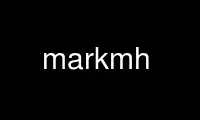
This is the command markmh that can be run in the OnWorks free hosting provider using one of our multiple free online workstations such as Ubuntu Online, Fedora Online, Windows online emulator or MAC OS online emulator
PROGRAM:
NAME
mark - manipulate message sequences
SYNOPSIS
mark [+folder] [msgs] [-sequence name ...] [-add | -delete] [-list] [-public | -nopublic]
[-zero | -nozero] [-version] [-help]
DESCRIPTION
The mark command manipulates message sequences by adding or deleting message numbers from
folder-specific message sequences, or by listing those sequences and messages.
A message sequence is a keyword, just like one of the “reserved” message names, such as
“first” or “next”. Unlike the “reserved” message names, which have a fixed semantics on a
per-folder basis, the semantics of a message sequence may be defined, modified, and
removed by the user. Message sequences are folder-specific, e.g., the sequence name
“seen” in the context of folder “+inbox” need not have any relation whatsoever to the
sequence of the same name in a folder of a different name.
Three action switches direct the operation of mark. These switches are mutually
exclusive: the last occurrence of any of them overrides any previous occurrence of the
other two.
The -add switch tells mark to add messages to sequences or to create a new sequence. For
each sequence named via the -sequence name argument (which must occur at least once) the
messages named via msgs (which defaults to “cur” if no msgs are given), are added to the
sequence. The messages to be added need not be absent from the sequence. If the -zero
switch is specified, the sequence will be emptied prior to adding the messages. Hence,
-add -zero means that each sequence should be initialized to the indicated messages, while
-add -nozero means that each sequence should be appended to by the indicated messages.
The -delete switch tells mark to delete messages from sequences, and is the dual of -add.
For each of the named sequences, the named messages are removed from the sequence. These
messages need not be already present in the sequence. If the -zero switch is specified,
then all messages in the folder are added to the sequence (first creating the sequence, if
necessary) before removing the messages. Hence, -delete -zero means that each sequence
should contain all messages except those indicated, while -delete -nozero means that only
the indicated messages should be removed from each sequence. As expected, the command
“mark -sequence foo -delete all” empties the sequence “foo”, and therefore removes that
sequence from the current folder's list of sequences.
When creating or modifying sequences, you can specify the switches -public or -nopublic to
force the new or modified sequences to be “public” or “private”. The switch -public
indicates that the sequences should be made “public”. These sequences will then be
readable by all nmh users with permission to read the relevant folders. In contrast, the
-nopublic switch indicates that the sequences should be made “private”, and will only be
accessible by you. If neither of these switches is specified, then existing sequences
will maintain their current status, and new sequences will default to “public” if you have
write permission for the relevant folder. Check the mh-sequence(5) man page for more
details about the difference between “public” and “private” sequences.
The -list switch tells mark to list both the sequences defined for the folder and the
messages associated with those sequences. Mark will list the name of each sequence given
by -sequence name and the messages associated with that sequence. If the sequence is
private, this will also be indicated. If no sequence is specified by the -sequence
switch, then all sequences for this folder will be listed. The -zero switch does not
affect the operation of -list.
The restrictions on sequences are:
· The name used to denote a message sequence must consist of an alphabetic character
followed by zero or more alphanumeric characters, and cannot be one of the (reserved)
message names “new”, “first”, “last”, “all”, “next”, or “prev”.
· Message ranges with user-defined sequence names are restricted to the form “name:n”,
“name:+n”, or “name:-n”, and refer to the first or last `n' messages of the sequence
`name', respectively. Constructs of the form “name1-name2” are forbidden for user
defined sequences.
Use markmh online using onworks.net services
